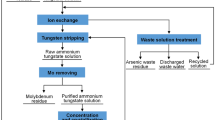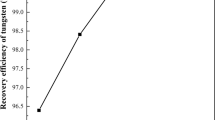Abstract
After years of exploitation of tungsten ore in China, the average grade of tungsten ore has decreased obviously, and the contents of impurities are getting higher and higher. Arsenic is commonly present in wolframite [(Fe, Mn)WO4] resulting in As-containing leaching residue. The residue is therefore classified as hazardous waste due to its heavy metal content, especially the arsenic content up to 2 wt%. The arsenic has to be removed before the residue can be used or treated. A technique involving sodium carbonate roasting–water leaching has been developed to remove arsenic from tungsten leaching residue efficiently. The optimized parameters were determined experimentally, and the reaction mechanisms have been analyzed by FactSage 8.1. The results show that the arsenic content in the residue can be reduced below 0.1% and the tungsten in the residue is also recovered in the same time.
Access this chapter
Tax calculation will be finalised at checkout
Purchases are for personal use only
Similar content being viewed by others
References
Pitfield P, Brown T (2011) Tungsten. British Geological Survey, Natural Environment Research Council
Premchand (1996) Processing of low grade tungsten ore concentrates by hydrometallurgical route with particular reference to India. Bull Mater Sci 19(2):295
Gedgagov EI, Besser AD, Yanakov VYa, Smolyarchuk VP (2009) Analyzing the raw materials market and methods for processing tungsten concentrates to obtain competitive products. Theor Found Chem Eng 43(4):529
Zhu X, Liu X, Chen X, Li J, He L, Zhao Z (2019) Comprehensive utilization and development trend of tungsten smelting slag. Conserv Utilization Mineral Resour 39(3):119
Dai Y, Zhong H, Zong H (2012) Novel process for preparation of mangano-manganic oxide from tungsten residue. Chin J Nonferrous Metals 22(4):1242
Luo X, Liu B, Tang M (2005) Experimental investigation of complex recovery of valuable minerals containing in the residue abandoned in wet-metallurgical process of wolframite. China Tungsten Ind 20(3):24
Liu H, Liu H, Nie C, Zhang J, Steenari BM, Ekberg C (2020) Comprehensive treatments of tungsten slags in China: a critical review. J Environ Manage 270:110927. https://doi.org/10.1016/j.jenvman.2020.110927
Chen YL, Guo XY, Wang QM, Tian HQ, Huang SB, Zhang JX (2021) Tungsten and arsenic substance flow analysis of a hydrometallurgical process for tungsten extracting from wolframite. Tungsten 3:348–360
**e H, Zhao ZW, Cao CF, Liang Y, Li JT (2012) Behavior of arsenic in process of removing molybdenum by sulfide method. J Cent South Univ 42(2):435–439
Duker AA, Carranza EJM, Hale M (2005) Arsenic geochemistry and health. Environ Int 31:631–641
Williams PN, Price AH, Raab A, Hossain SA, Feldmann J, Meharg AA (2005) Variation in arsenic speciation and concentration in paddy rice related to dietary exposure. Environ Sci Technol 39:5531–5540
Li YL, Zhao ZW (2017) Separation of molybdenum from acidic high-phosphorus tungsten solution by solvent extraction. JOM 69(10):1920–1924
Yang Y, **e BY, Wang RX, Xu SM, Wang JL, Xu ZH (2016) Extraction and separation of tungsten from acidic high-phosphorus solution. Hydrometallurgy 164:97–102
Liu CP, Luo CL, Gao Y, Li FB, Lin LW, Wu CA, Li XD (2010) Arsenic contamination and potential health risk implications at an abandoned tungsten mine, Southern China. Environ Pollut 158:820–826
Wang X, Ma X, Su K, Liao C, Zhao B (2020) Fundamental studies for high temperature processing of tungsten leaching residues for alloy formation. Tungsten 2(4):362–370
Wang X, Ma X, Liao C, Zhao B (2020) High temperature processing of tungsten slag. In: Proceedings of the 11th international symposium on high-temperature metallurgical processing. The Minerals, Metals & Materials Series, San Diego; Springer, Cham, pp 289–294
Su K, Ma X, Zhao B (2021) Harmless treatment and valuable metals recovery of tungsten leaching residues: a thermodynamic and experimental study. JOM 73(6):1937–1946. https://doi.org/10.1007/s11837-021-04682-2
Bale CW, Bélisle E, Chartrand P, Degterov SA, Eriksson G, Gheribi AE, Hack K, Jung IH, Kang YB, Melançon J, Pelton AD, Petersen S, Robelin C, Sangster J, Spencer P, Van Ende MA (2016) FactSage thermochemical software and databases. Calphad 54:35–53
Author information
Authors and Affiliations
Corresponding author
Editor information
Editors and Affiliations
Rights and permissions
Copyright information
© 2022 The Minerals, Metals & Materials Society
About this paper
Cite this paper
Xu, L., Liao, C., **e, S., Zhao, B. (2022). Removal of Arsenic from Leaching Residue of Tungsten. In: Peng, Z., et al. 12th International Symposium on High-Temperature Metallurgical Processing. The Minerals, Metals & Materials Series. Springer, Cham. https://doi.org/10.1007/978-3-030-92388-4_8
Download citation
DOI: https://doi.org/10.1007/978-3-030-92388-4_8
Published:
Publisher Name: Springer, Cham
Print ISBN: 978-3-030-92387-7
Online ISBN: 978-3-030-92388-4
eBook Packages: Chemistry and Materials ScienceChemistry and Material Science (R0)




